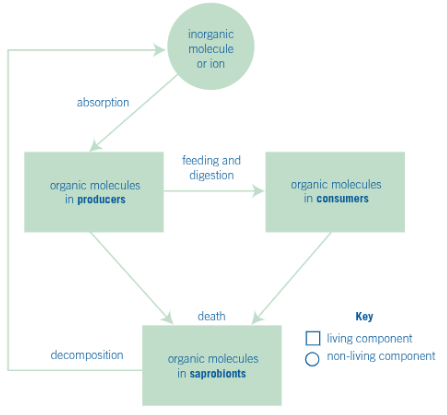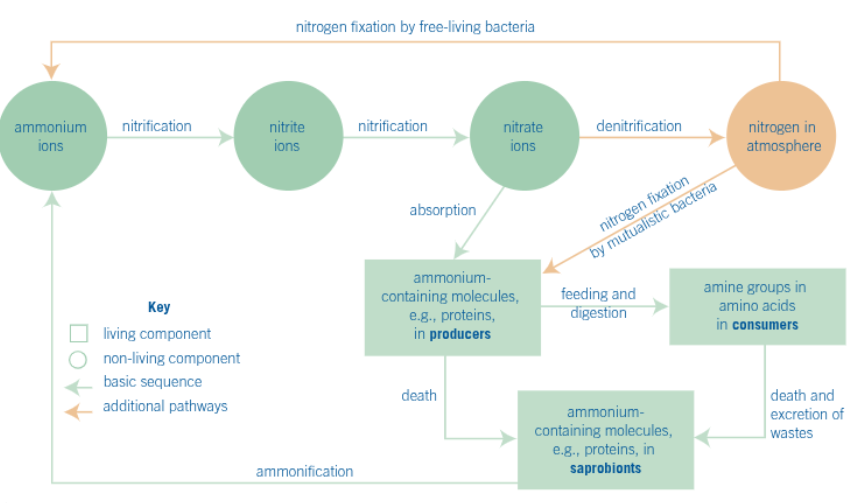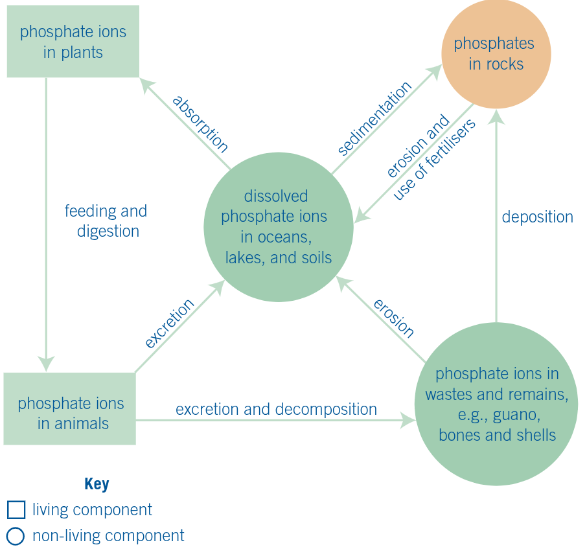3.5.3 + 3.5.4 energy and ecosystems and nutrient cycles
1/18
There's no tags or description
Looks like no tags are added yet.
Name | Mastery | Learn | Test | Matching | Spaced |
|---|
No study sessions yet.
19 Terms
role of a producer
to absorb light energy and use it to convert atmospheric or aquatic carbon dioxide to glucose and other sugars, they are photo autotrophs
biomass
mass of carbon in an organism/ dry mass of tissue
how is biomass formed
photosynthesis produces glucose (chemical energy) which is either used as a respiratory substrate or is used to build large biological molecules within producers causing the formation of biomass
2 ways of measuring biomass
dry mass per area per time/ carbon per area per time (Kg m-2 yr -1), calorimetry
working out the dry mass of the tissues
weigh crucible without sample, place sample in crucible and put in oven at a low temperature to prevent burning, remove and weigh crucible and sample at regular intervals until mass is constant (all water removed), from final constant mass subtract mass of crucible
limitations of measuring dry biomass
difficulty in finding a representative sample of the entire ecosystem, destruction of samples in some methods of measuring biomass, variability in biomass over time so hard to get precise measurement
using calorimetry
calorimeter burns dried sample and uses the energy released to heat a known volume of water, measure change in temperature of water, temperature change can be used to estimate chemical energy stored within the sample using specific heat capacity
limitations of calorimetry
can take long time to fully dehydrate, all of the sample may not be burnt, water may not be pure so specific heat capacity not fully accurate, precise equipment needed which is not always available, some heat released will be lost to surroundings and beaker
photosynthetic ineffieciency - why only 3 % of sunlight is converted in chemical energy
light falls onto a non-photosynthetic part of the plant, light misses the plant and hits the ground, green light is reflected by the leaves, only some wavelengths absorbed, some light transmitted through the leaf, inefficient conversion of light energy to organic molecules by chlorophyll
reasons for energy loss between producer and consumer
not all parts of plant can be eaten, not all parts can be digested, therefore lost as faeces, some energy is lost through excretory processes e.g. urine, heat energy losses during consumers digestive process
gross primary production (GPP)
amount of light energy converted to chemical energy (in the biomass) in a given area (KJ m-2)
net primary production (NPP)
the amount of chemical energy left after respiration (KJ m-2) - NPP = GPP-R
net production in consumers/ secondary production (N)
energy left in animal after it ingests plants and loses energy to faeces / urine and heat through respiration: N = ingested chemical energy - (energy lost in faeces and urine + energy lost in respiration)
% efficiency of energy transfer
(net production of trophic level/ net production of previous trophic level) x 100
nutrient cycle
leaves from plants die and fall on the ground, detritivoresbreak apart leaf tissues, sapotrophs break down organic matter and release inorganic nutrients, plants take up inorganic nutrients from soil

mycorrhizal interactions - symbiosis
hyphae greatly increase SA of root systems of plants, increasing the amount of water and mineral ions (e.g. nitrates and phosphates) that can be absorbed by the plants' roots, in return, fungi receive organic compounds from the plant
which molecules require phosphorus
DNA, ATP, phospholipids, NAD, NADP, FAD, acetyl coa
nitrogen cycle

phosphorus cycle
weathering releases phosphates from rocks, assimilation (plants absorb phosphates via roots) consumption (animals obtain phosphorus by eating plants), decomposition (saprobionts return phosphates to the soil and water) and sedimentation (phosphates accumulate in ocean beds and form new rocks)
